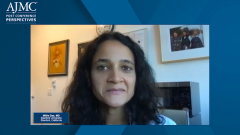
HUDSON Trial Overview and Key Takeaways
The HUDSON trial is explored by Dr Das as she provides an overview of the study and offers key considerations regarding results.
Episodes in this series

Millie Das, MD: The HUDSON trial was a multi-arm umbrella trial for patients with advanced non–small cell lung cancer who were previously treated with platinum-doublet chemotherapy and immunotherapy, either separately or in combination. These patients had disease progression on prior immunotherapy. They went on to undergo tumor molecular analysis, and then were enrolled into either a biomarker-matched subgroup, which was group A, or a biomarker-nonmatched cohort, which was group B. The investigators then assessed overall response rate as well as progression-free survival and overall survival, and used that to decide whether to expand each initial cohort size while safety was continually monitored.
The investigators looked at durvalumab in combination with either olaparib, a PARP inhibitor; danvatirsen, a STAT3 inhibitor; ceralasertib, an ATR inhibitor; and oleclumab, an anti-CD73 antibody. For the PARP inhibitor, patients in group A had biomarker expression of the HHR pathway, or LKB1. For the ATR inhibitor, patients in group A had ATM deficiency, which is part of the DDR pathway.
The investigators ultimately reported that the overall response rate and the median progression-free survival and overall survival were longest in patients receiving durvalumab plus ceralasertib, which is an ATR inhibitor, with efficacy appearing greatest in the biomarker-matched cohort, where we saw an overall response rate of close to 30%. The safety of this drug combination also appeared to be manageable. This represents a promising efficacy signal in this cohort of patients with immunotherapy resistance. In this study, the overall number of patients was small in each of these cohorts, but this preliminary efficacy certainly warrants further exploration in a larger phase study.
[Treatment of patients with advanced non–small cell cancer with disease progression on prior anti–PD-L1 therapy] is certainly an unmet need because we encounter it frequently in the clinical setting and we don’t have great treatment options. I typically offer patients single-agent chemotherapy with docetaxel or gemcitabine. I like the idea of doing further biomarker testing to help individualize the treatment approach, because we’re realizing that a one-size-fits-all approach may not work moving forward.
There’s now the ongoing phase 3 LATIFY study, which is evaluating durvalumab plus ceralasertib compared with docetaxel in a biomarker-nonmatched patient population after progression on prior I/O [immuno-oncology]. This study will be interesting to follow in the years ahead.
Transcript edited for clarity.
Newsletter
Stay ahead of policy, cost, and value—subscribe to AJMC for expert insights at the intersection of clinical care and health economics.









